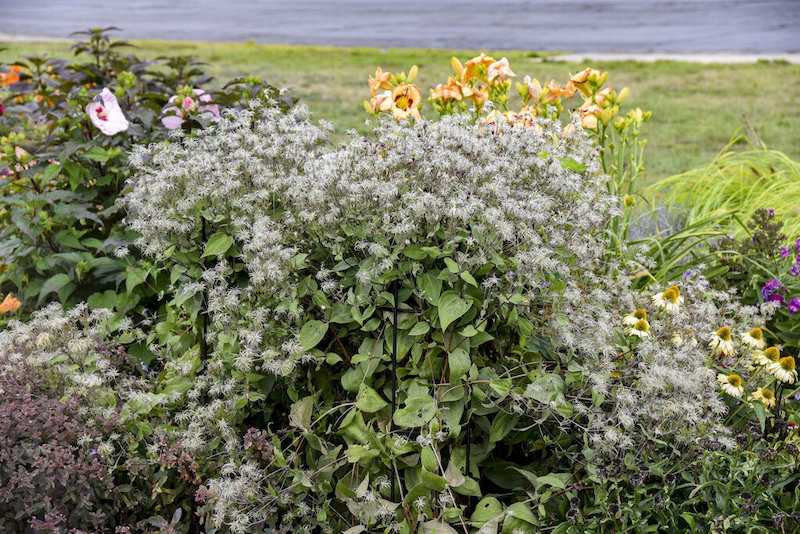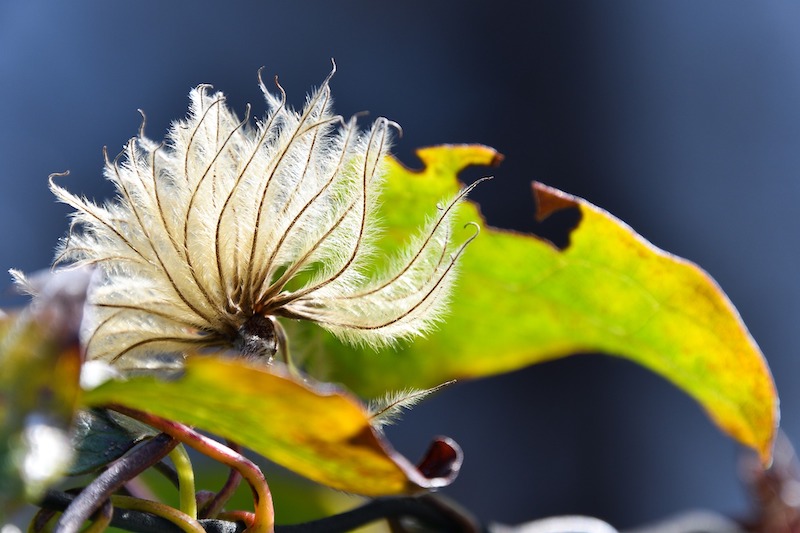Clematis is a genus of vines and shrubs treasured for their beautiful flowers. While clematis is relatively easy to grow, these plants can sometimes be affected by fungal or viral pathogens. Clematis is commonly affected by powdery mildew, root rot, viruses, and clematis wilt. Powdery mildew and viruses are mostly cosmetic concerns, while root rot and clematis wilt can be more severe. These diseases can be managed through cultural, mechanical, and chemical controls with prevention being the greatest line of defense.

Powdery Mildew
Powdery mildew is a disease of clematis caused by the fungal pathogen Erysiphe. This disease spreads by wind and is favored by warm temperatures and high humidity, typically appearing in summer and fall. Unlike many other fungal diseases, powdery mildew does not require moist conditions to spread and infect plants. Clematis planted in shady, overcrowded locations are more likely to be affected by powdery mildew. The disease is rarely fatal to healthy clematis.
Identifying Powdery Mildew
Powdery mildew is easily recognizable by white or gray dusty growth on the surface of leaves. Small black fruiting bodies may also be present. In severe infections, leaves may wilt and growth may be slowed.
Treating Powdery Mildew
Space and prune your clematis to improve air circulation. Remove all infected plant material, including dead leaves and twigs. Fungicides can be used to prevent this disease where powdery mildew is prevalent. Clematis should be sprayed early in the season before symptoms appear. Reapplications are needed every 2 weeks. Select a fungicide that is labeled for use on clematis, as some fungicides are phytotoxic to these plants.
Clematis Wilt
Clematis wilt is one of the most serious diseases of clematis. Known as Phoma clematidina, this fungal pathogen is a leaf spot disease that overwinters in the soil and on infected plant material. High humidity, warmer temperatures, and abundant precipitation favor this disease; most infections start in summer. Clematis wilt can result in aboveground dieback or death of the entire plant. While the damage is severe, clematis plants can also recover from this disease in future growing seasons. Large-flowered clematis hybrids are most susceptible to this pathogen, whereas small-flowered hybrids and straight species of clematis are more resistant.
While Phoma clematidina is the most significant leaf spot disease of clematis, pathogens such as Botrytis, Phyllosticta, and Cylindrosporium may also affect this plant. Symptoms and management are similar to Phoma clematidina.
Identifying Clematis Wilt
Brown-to-black lesions will form on the leaves and girdle the stems as they spread. Lesions can also be red or purple in color, especially along the veins of the plant. Stems will quickly wilt, collapse, and die down to the soil level.

Treating Clematis Wilt
Monitor your clematis for signs of clematis wilt early since it moves quickly through infected stems. Prune out any stems and vines showing symptoms of clematis wilt. Prune and space plants well to maintain adequate air circulation. Some fungicides may also work as a preventative measure against clematis wilt – just be sure that they are labeled for use on clematis. Grow resistant species and varieties of clematis if needed.
Root Rot
Root rot is a disease that affects clematis and many other garden plants. In clematis, it is most often caused by the oomycete Phytophthora, a fungus-like pathogen. Symptoms usually do not appear until it is too late, and entire plants may die. Root rot can affect clematis at any point during the growing season. It is especially prevalent in overly wet conditions caused by flooding, high precipitation levels, or overirrigation.
Identifying Root Rot
Root rot first appears as wilting and yellowing leaves. Eventually, the lower stems may rot and collapse at the soil line. Roots will be brown, soft, and mushy.
Treating Root Rot
Root rot is best controlled via prevention. Maintain adequate air circulation by pruning your clematis. Avoid overwatering your plants; established clematis should only be watered when the soil is slightly dry – about 1 inch of water per week. Keep foliage and stems dry when watering. If your clematis is planted in a low-lying area where water pools after rain events, transplant it to a better spot. Remove and destroy all infected plant material.
Viruses
There are many viruses that attack clematis throughout the growing season, namely Tomato Ringspot Virus (ToRSV) and Cucumber Mosaic Virus (CMV). These viruses are vectored by pests such as aphids or nematodes. While less common, viruses can also be spread by contaminated pruners, scissors, or loppers. Viruses are not a major health concern for clematis but may result in slow overall growth.
Identifying Viruses
The symptoms of viruses in clematis are relatively similar across all pathogens. Check for wilted, stunted growth with yellow streaking, spotting, or mottling in the leaves. The symptoms of viruses can often mimic those of nutrient deficiencies. Send a tissue sample to your local extension office to confirm a diagnosis.
Treating Viruses
There is no way to cure clematis from viral infections. The plants will survive the infection and may even recover in subsequent growing seasons. Do not vegetatively propagate clematis that are infected with a virus. All clonal offspring from infected clematis will also be infected with the virus. Always sterilize your pruning tools with a 10% bleach solution before using them. If desired, you may dig up and replace infected clematis with new, disease-free plants.
Clematis Disease Chart
|
Disease |
Identifying |
Treating |
|
Powdery Mildew |
White powdery growth on leaves |
Air circulation, fungicides |
|
Clematis Wilt |
Lesions on stems and leaves, girdling, wilting, dieback, death of plant |
Prune out infected stems and vines, apply fungicides, plant resistant varieties |
|
Root Rot |
Rotted, mushy stems and roots, wilting, death of plant |
Avoid overwatering, transplant to well-drained soil, provide air circulation |
|
Viruses |
Yellow mottling and streaking of leaves |
Sterilize pruning tools, avoid vegetatively propagating infected plants |
Sources: "Clematis Diseases." PennState Extension. extension.psu.edu
 |
Lauren Youngcourt - Published 05-11-2023 |
